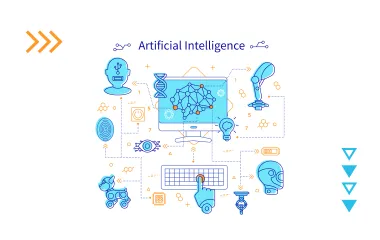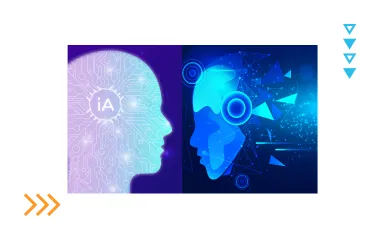Embedded Software Development: Process and Best Practices

Contents
Embedded systems play an essential role in the functionality of many devices. We are talking about the whole range of devices from household appliances to industrial machinery or advanced automotive systems.
What is the role of embedded development in this? Embedded software development is the system’s foundation, enabling hardware to perform complex and dedicated tasks efficiently. As the demand for smarter, more connected devices grows, the importance of robust, high-quality embedded software development services cannot be overstated.
This article will explore the stages of the embedded software development process, tools for embedded system software development, crucial parts of the embedded system, etc.
Whether you are developing a new IoT device, upgrading industrial control systems, or enhancing consumer electronics you will need someone who can provide first-class embedded software development services.
At Waverley Software we will navigate you through the exciting world of embedded product development and embedded software design, offering practical advice, expert tips, and excellent embedded system development services.
Embedded Market Overview
Embedded devices are used across various industries, such as automotive, healthcare, military, customer electronics, and IoT. Logically, the embedded system development market is continuously growing, as processes, tools, and technologies are also developing.
If we check the latest reports featuring trends in the embedded market we can see the predicted immense growth of software development in embedded systems.
Cross-industry usage has spurred the adoption of embedded systems, an industry that is speculated to rise at a 5.80% CAGR from 2024 to 2034 according to the Future Market Insights.
Fortune Business Insights Report states that the global embedded systems market size is projected to grow from $100.04 billion in 2023 to $161.86 billion by 2030, at a CAGR of 7.1% during the forecast period 2023-2030.
The Precedence Research shows that the global embedded systems market size reached USD 162.3 billion in 2022 and is expected to hit around USD 258.6 billion by 2032, poised to grow at a CAGR of 4.77% during the forecast period from 2023 to 2032.
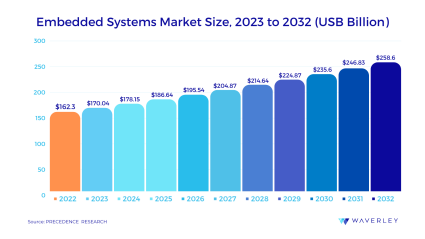
Let’s look deeper into the factors that drive market growth.
Increased Usage of Embedded Systems Technology for Healthcare Applications
Embedded systems technology is crucial in developing medical devices that can improve patient outcomes, reduce costs, and increase efficiency, devices providing the processing power, memory, and connectivity needed to support the advanced functionality. For instance, there are numerous devices that monitor vital signs such as blood pressure, heart rate, and oxygen saturation levels. They often rely on embedded systems technology to collect, process, and transmit data and to provide alerts and notifications when abnormal values are detected.
In addition, there is also a growing demand for connected medical devices that can transmit data to healthcare providers in real time. This drives the adoption of IoT-enabled medical devices, which often rely on embedded systems technology to support their connectivity and data processing requirements. Thus, the rising demand for medical devices is expected to drive the embedded systems market.
Increased Demand for Electric and Hybrid Vehicles
In the case of electric and hybrid vehicles, embedded systems are used for various functions such as:
- controlling the electric motor
- managing battery charging and discharging
- monitoring the vehicle’s performance
- providing information to the driver.
As the demand for electric and hybrid vehicles continues to grow, the demand for embedded systems that can handle these functions is also increasing. As a result, the embedded system market is expected to grow considerably, largely driven by the increasing demand for electric and hybrid vehicles. This growth is expected to be particularly strong in areas such as automotive electronics, power management systems, and electric vehicle charging infrastructure, which relies heavily on embedded systems technology.
Increased Interest in Sustainable Movements
Energy-efficient solutions, like smart grid management systems, environmentally friendly transportation systems, and green building automation, are being developed with the help of these systems.
This driver encourages using these systems that support sustainability while satisfying operational and technical needs. It also demonstrates a rising global awareness of environmental challenges.
What About Market Challenges and Opportunities?
The development of embedded systems is relatively high-priced which can restrain the demand for embedded systems in the market. Embedded systems can be complex to design and manufacture, requiring specialized components and production processes. This can result in higher manufacturing costs, making it difficult for some companies to enter, and higher consumer prices. In addition, the cost of developing embedded systems can be significant, particularly for highly specialized applications or industries with strict safety or regulatory requirements. This can be a significant barrier to entry for smaller companies and limit the pace of innovation in the market.
However, as demand for embedded systems grows, manufacturing costs will likely continue to decrease, making these systems more accessible to a broader range of companies and industries.
Talking about market opportunities we need to mention the following factors that are likely to create more opportunities in the near future for the software development embedded market:
- Development of autonomous vehicles
- The rise of IoT app development
- Increasing demand for smart home technology
Based on the recent reports, the growing research to develop AI-based embedded systems, specifically AI in Robotics will be one of the future market trends. At present, North America holds the largest share of the embedded market and determines the trends, however, China is anticipated to grow with the highest CAGR in the future.
The Main Types of Embedded Systems
Here at Waverley, we have delivered multiple embedded software solutions to clients from a variety of industries. Hence, our embedded software engineers have first-hand experience with different types of these platforms.
Let’s get started with the basics, and define the embedded systems. They are simply a combination of computer hardware and software tools. Explicitly, the term refers to hardware embedded with a particular kind of software to perform a definite function.
Embedded systems can be independent or work as part of a larger platform, but whatever the case may be, each unit is programmed to carry out a specific task. Often, they will be used to monitor the performance and operations of the device they are embedded into. Thus, helping ensure that everything works properly.
There are many different types of embedded systems and device classifications based on the types of embedded systems, performance, or functionality. Let’s look deeper into those classifications.
The Main Classification of Embedded Systems
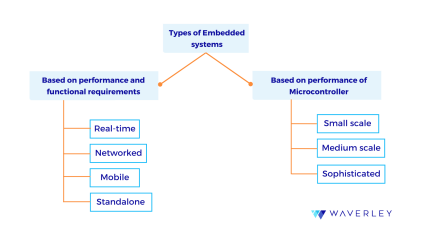
Based on performance and functional requirements these are the main systems: network, mobile, and standalone. As a separate entity, we will talk about real-time embedded systems, which could be divided into soft and hard versions.
Based on the performance of the microcontroller we could define 3 types of embedded system software such as small-scale, medium-scale, and sophisticated.
Additionally, specialists can categorize embedded systems based on battery life duration.
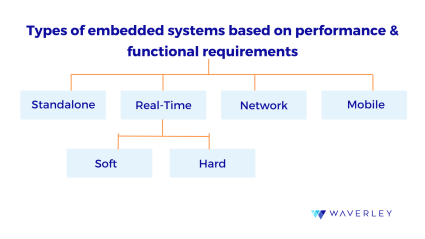
- Real-Time Embedded Systems
This kind of embedded software needs to deliver outputs promptly, within a particular time frame. Hence, it is often used in time-sensitive sectors like transportation, manufacturing, and even healthcare, as all of these spheres rely on delicate processes to perform their business. Some examples of real-time embedded systems are aircraft or autonomous vehicle controls, and traffic monitoring tools.Real-time embedded systems can be broken down into ‘soft’ and ‘hard’ categories. The former refers to those in which the time frame doesn’t need to be strictly followed. That is to say, if the deadline of a particular task had passed and the system didn’t produce the needed result in time, the output would still be accepted. Conversely, in the case of hard real-time embedded systems, the time frame has to be followed strictly and if the deadline is not met, the result may not be accepted. Let’s check the examples in detail:
- Soft real-time embedded systems: temperature or humidity monitoring tools. A minor delay in the acquisition of real-time temperature data might not be considered too critical, and obtaining the information a bit later will still be valuable.
- Hard real-time embedded systems: aircraft control platforms. In this case, even a small delay in data acquisition can lead to disastrous consequences as the pilot might make a decision based on outdated information.
- Standalone Embedded Systems
This type of embedded software can work by itself, without requiring a host like a computer or processor. It simply takes input data in its digital or analog form and delivers an output that might be displayed through a connected device.Instruments like cameras, digital watches, and MP3 players are all examples of standalone embedded systems. They work by themselves, without relying on a larger platform.
- Network Embedded Systems
This type of embedded system relies on wired or wireless networks for output generation. Often, these kinds of platforms are built on general-purpose processors and consist of various components like sensors, controllers, and the like.The most popular examples of network-embedded systems are home or office security systems, point-of-sale tools, and ATMs. All of these solutions rely on networks of other devices to carry out their function. For instance, a security system includes sensors, cameras, alarms, and similar gadgets to monitor for intrusions and alert the security staff.
- Mobile Embedded Systems
Mobile embedded systems are portable and easy to move around. Typically, they are used in different kinds of mobile devices but naturally have some constraints when it comes to memory size. Despite the memory and functionality limitations, mobile embedded systems are quite popular solely because they work on the go.The classification based on the microcontroller performance is not the main one, but it helps in understanding the complexity, functionality, and resource requirements of various embedded systems.
Embedded systems: Microcontroller Performance
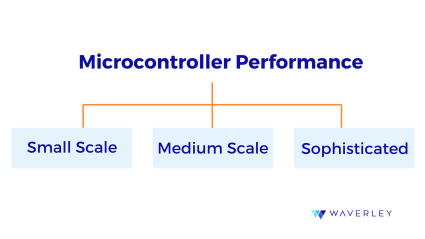
| Small-Scale Embedded Systems | Medium-Scale Embedded Systems | Sophisticated Embedded Systems |
|---|---|---|
These systems are designed using an 8-bit or 16-bit microcontroller and can be powered by a battery. In this case, the processor leverages very little memory resources and works at a limited speed. Small-scale embedded systems are typically used in devices that have basic functions such as temperature monitoring, simple displays, and basic input/output operations. | This category is developed with 16-bit or 32-bit microcontrollers. Naturally, these embedded systems are faster and somewhat more complex than the small-scale ones. For example, these systems are often used in devices that require more complex functions like digital signal processing, data storage, and UI control. | Sophisticated systems work on multiple algorithms and have complex hardware and software components. Often, they require a processor that can be configurable. These solutions are designed using various 32-bit or 64-bit microcontrollers and require a lot of memory to perform well. |
Embedded systems can be classified based on their battery life duration, which significantly impacts their design, application, and usage scenarios.
| Short-Term Battery Life Systems | Medium-Term Battery Life Systems | Long-Term Battery Life Systems | Ultra-Long-Term Battery Life Systems |
|---|---|---|---|
| Duration: Hours to days | Duration: Days to weeks | Duration: Weeks to months | Duration: Months to years |
Characteristics:
| Characteristics:
| Characteristics:
| Characteristics:
|
Examples:
| Examples:
| Examples:
| Examples:
|
Parts of Embedded Software Systems
From the smartphone in your hands to the home or kitchen appliances, and even the sophisticated machinery in industrial settings – embedded systems are the hidden heroes that make everything work.
The components of an embedded system include a combination of hardware and software. The hardware consists of microcontrollers/microprocessors, and memory, on the other hand, the software part includes the system software, application software, and the OS (most systems are using RTOS). Separately we can define interface components such as input/output devices (such as sensors, actuators, and displays), and various interfaces for connectivity.
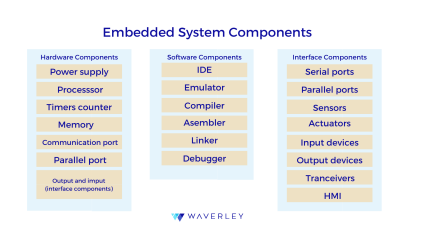
Embedded software engineers declare that hardware and software components both make up an embedded system. It also goes by the name ‘firmware’ when it performs certain tasks. The employment of embedded systems has impacted every aspect of daily life.
Hardware Components of an Embedded System
| Hardware Component | Characteristics |
|---|---|
| Power Supply | The system will either have its own power supply or, if it is a component of a larger system, it will draw power from that system. Donate to a system that the embedded system interfaces with, like a network card. |
| Processor | Any embedded system’s core component is the CPU. It determines how well the system works. There are many categories of processors. One of the classifications divides processors into 8-bit, 16-bit, 32-bit, or 64-bit CPUs. For embedded systems, smaller applications require fewer bits. Large applications call for embedded systems with larger bit processors. The most commonly used processors are microprocessors and microcontrollers. |
| Timers Counter | Some applications need a delay, such as LED display apps, which need one so that the LED can keep blinking. Timers are employed for this reason in embedded systems. Mechanisms are often required in embedded systems to count the occurrence of things and carry out actions at regular intervals. Time boundaries apply to embedded systems when counting the number of events or the interval between them. |
| Memory | The microcontroller itself contains two different types of memory: RAM and ROM. ROM is a code memory, whereas RAM is a volatile memory. In embedded systems, several types of system memory exist, including internal memory at the microcontroller, RAM at the system on a chip or external RAM, internal caches at the microprocessor, external RAM chips, ROM / PROM, and Flash / EEPROM. |
| The Communication Port | You can communicate with other embedded systems via this interface. Various communication interfaces are available in embedded systems, including UART, USB, Ethernet, RS-485, and many more. A serial port is an interface for serial communication in which data is transferred one bit at a time. The serial protocols UART, SPI, SCI, and I2C are often used. |
| Parallel Port | Peripheral connections are made via a parallel port. The term alludes to the method of data transmission, where parallel ports send several bits of data simultaneously. In comparison to modern serial ports, parallel ports have more data lines and require longer cables and port connectors. |
| Output And Input | Input is necessary to communicate with the embedded system. Inputs can include a keyboard, touchpad, camera, microphone, GPS, and various sensors. An output device is a hardware component that connects to a primary device, such as a computer and transforms received data from the processing unit into a human-perceptible form that users can understand and use. This can be text, graphics, audio, or video. |
Software Components of Embedded System
As it was covered hardware and software modules come together to form an embedded system. Now let’s focus on the software components. Software for computers and embedded systems serves quite distinct functions. Computer software can be placed on various devices to accomplish the desired goals. However, embedded system software is created for a given device to accomplish a given goal.
| Software Components | Characteristics |
|---|---|
| IDE (Integrated development environment) | The first tool you need for embedded system software is an editor. The text file you create in the editor will contain the code you write using any suitable programming language. |
| Emulator | An emulator is a piece of software that enables you to use the features of the host system. All the parts are controllable through the emulator tool. The emulator is also used to debug applications. The primary function of the emulator is to simulate a genuine system’s behavior in the embedded system. You may simulate how the code will operate in real time by using an emulator. |
| Compiler | The written programs that translate source code from a high-level programming language into a low-level programming language are referred to as ‘compilers.’ A compiler is a piece of software that transforms a programming language into a language the target machine can comprehend and use to execute the functions. |
| Assembler | The assembler works when the programming language used to create the application is assembly language. After that, the assembly language program is converted to HEX code so it may be processed further. After the code is written, the programmer is used to write the program into the chip. |
| Linker | Software is written in discrete modules and components called ‘linkers.’ A linker, often known as a link editor, is a program that merges one or more object files into a single executable code. |
| Debugger | A debugger is a tool used for testing and debugging. It examines the code, finds where errors and problems are, removes them, and notes their locations. Programmers can confront and correct mistakes rapidly. |
Embedded Software Architecture: 3 Main Components
To fully cover the topic we should pay attention to the embedded software development process, especially, software architecture and embedded programming software.
Let’s start with the software architecture. Here we need to take into consideration 3 main components: operating system, device drivers, and application software.
- Embedded Operating System:
Depending on the complexity of the embedded system, an operating system (OS) may or may not be present. Real-time operating systems (RTOS) are common in applications requiring precise timing and responsiveness. For simpler systems, a bare-metal approach may be adopted, where the software directly interacts with the hardware. - Device Drivers:
Device drivers act as a bridge between the operating system and the hardware, facilitating communication and control. Well-designed device drivers are crucial for efficient utilization of hardware resources and ensuring seamless operation. - Application Software:
The application software is tailored to the specific functionality of the embedded system. This software layer defines how the system responds to inputs, processes data, and generates outputs. Optimization is key to ensuring that the application software meets performance requirements within the given hardware constraints.
The embedded programming software mainly focuses on low-level programming, hardware-software interaction, real-time constraints, and optimizing for limited resources (such as memory and processing power).
Embedded Software Development Process
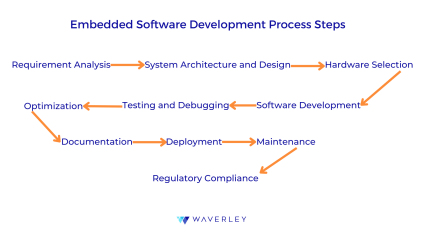
The embedded software development process is similar to the software development processes in general but it has certain specific features. We will guide you through the steps of the process.
1. Define the Product Specs
The first step in the embedded software development procedure is collecting all the possible data. The product should answer these questions:
Problem – What problems does the product solve? What value will it bring to the customer’s life?
2. Structural Architecture
The software architecture includes:
- The final cut of the design
- Strategies involved
- Type of wired or wireless connectivity to be used
- Type of power supply
- How the hardware design will look like
- Web app/Cloud-based app/Desktop software/Mobile app design
On the contrary, the hardware design involves selecting the specific component for every aspect of the circuit’s parameters. Combining the architecture blueprints, one can get closer to executing this flow chart in the embedded systems development process.
3. PoC / Prototype Development
PoC is specially drafted to note the details of the prototype software. In this stage, quality experts develop and thoroughly test the prototype. It is crucial to first develop a prototype, ensure its topmost quality, and collect feedback.
4. Testing & Field Trials
Products that give perfect results during lab testing sessions but don’t perform up to the mark when on the field. Therefore, it’s recommended that hardware QA testing be conducted in the proper environment. Waverley’s specialists have profound experience in providing stress hardware QA tests.
5. Product Release
Now that the product is ready to be launched into the outer world for startup and enterprise use the only thing to be done is to get the hardware product certification that will be managed using this embedded software.
Recommended Best Practices for Embedded Software Development Process
There are many ways to integrate embedded software development processes, let’s have a closer look at the ones considered to be best practices. Incorporating best practices like modular design, code reviews, and CI/CD into the embedded software development process can significantly enhance maintainability, scalability, and reliability. Here’s a more detailed look at these practices:
- Modular Design
Develop software in modular components to improve maintainability and scalability. - Code Reviews
Regularly review code with peers to catch issues early. - Continuous Integration/Continuous Deployment (CI/CD)
Automate testing and deployment to catch issues early and streamline the release process.
Tools for Embedded System Software Development
Embedded system software development requires specific tools to create reliable, and high-performance code for embedded systems. We are talking about compilers, debuggers, and IDEs (integrated development environments).
1. Compilers
Compilers are significant tools in embedded software development because they translate high-level programming languages like C or C++ into machine code. The translated code can be executed by the target embedded system’s processor.
Types of Compilers:
- Cross-Compilers: These compilers run on one platform (e.g., a PC) but generate code for a different platform (e.g., an embedded system).
If there is a need to develop software for multiple platforms or if your resources are limited – cross-compilers are the best option. - Native Compilers: These compilers run on the same platform as the target system.
Advantages of the native compilers include producing highly optimized code, easy setup, and better efficiency in terms of memory.
| Feature | Description |
|---|---|
| Optimization | Compilers optimize code to improve performance, reduce code size, and conserve power. |
| Target-specific Code Generation | Compilers generate code specific to the target microcontroller or processor, including instruction sets and memory configurations. |
| Support for Embedded Development Tools | Compilers often integrate with other tools used in embedded development, such as debuggers and IDEs. |
The Most Common Compilers Used in Software in Embedded Systems
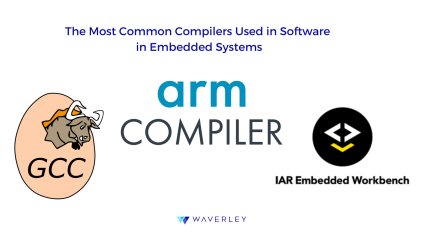
- GNU Compiler Collection (GCC)
GCC is a free and open-source compiler that supports a wide range of programming languages, including C, C++, and assembly. It is highly configurable and optimized for various embedded architectures. - ARM Compiler
Developed by ARM, this compiler is specifically designed for ARM-based processors commonly used in embedded systems. It offers high-performance code generation and optimization for ARM architectures. - IAR Embedded Workbench
This is a popular commercial compiler for embedded systems, known for its high optimization levels and comprehensive debugging features. It supports a wide range of microcontrollers and architectures.
2. Debuggers
Like in any other system, debuggers are necessary tools for identifying and fixing bugs and issues in embedded software. They allow developers to inspect the program’s execution, set breakpoints, and analyze variables.
| Debugging Techniques | Description |
|---|---|
| Printing Debug Information | Using print or similar functions to print debug messages to a serial port or display. |
| LEDs and GPIOs | Using LEDs or GPIO pins to indicate the state of the system or specific variables. |
| Debuggers | Tools used to test, find, and fix errors (bugs) in their code, providing insights into the execution of programs. |
| Logic Analyzers and Oscilloscopes | Hardware tools are used to monitor and analyze digital and analog signals in real-time. |
Most common Debuggers Used in Embedded Development Processes
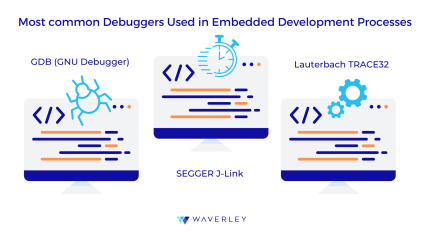
- GDB (GNU Debugger)
GDB is a powerful open-source debugger that supports multiple programming languages and platforms. It provides a command-line interface for debugging embedded software. - SEGGER J-Link
J-Link is a popular hardware debugger that supports a wide range of microcontrollers and development environments. It offers high-speed debugging and programming capabilities. - Lauterbach TRACE32
TRACE32 is a comprehensive debugger that supports real-time tracing and debugging of embedded systems. It offers advanced features for code analysis and optimization.
3. Integrated Development Environments
IDEs provide a comprehensive environment for embedded software development, integrating various tools such as editors, compilers, debuggers, and project management features.
The IDEs Used in Embedded Development
- Eclipse: Eclipse is a widely used open-source IDE that supports multiple programming languages and platforms. It offers a rich set of features for embedded development, including code editing, debugging, and project management.
- Keil µVision: Developed by ARM, µVision is a popular IDE for embedded development. It offers a user-friendly interface, integrated debugger, and support for a wide range of ARM microcontrollers.
- Visual Studio with VisualGDB: Visual Studio is a popular IDE for Windows development, and when combined with VisualGDB, it becomes a powerful tool for embedded development. VisualGDB provides seamless integration with Visual Studio and supports a wide range of embedded platforms.
When you choose an IDE it’s important to make sure that the IDE supports the microcontroller or processor architecture you are using. Also, consider how well the IDE integrates with other development tools you are using, such as compilers and debuggers.
Choosing the right tools for your project will determine the success of the whole process, so it’s recommended to follow trustworthy embedded software development services providers.
Challenges in Embedded Software Development
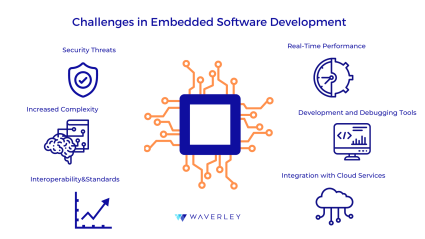
Considering the complexity of this area of programming, embedded systems development might be exposed to fundamental challenges. Among them are data security, and choosing the right OS and programming language, or hardware platform.
Today, the landscape of embedded software development continues to evolve, highlighting new emerging challenges. The main challenges faced in embedded software development today are:
- Security Threats
As embedded devices become more interconnected, they are increasingly targeted by advanced cyber threats. Moreover, it’s becoming more difficult to keep up with the security standards. Keeping up with evolving security standards and implementing robust security measures within constrained environments is important to ensure the security of modern hardware devices. - Increased Complexity
Integrating AI/ML capabilities into embedded systems requires significant processing power and sophisticated algorithms. Also, the demand for more processing at the edge introduces complexity in managing data and ensuring real-time performance. - Interoperability & Standards
Ensuring compatibility with various IoT platforms and communication protocols is challenging and at the same time navigating and complying with multiple industry-specific standards and protocols. - Development and Debugging Tools
There is a need for more sophisticated debugging tools to handle complex, real-time embedded systems. - Real-Time Performance
Here we are talking about latency reduction. Minimizing latency for real-time applications, especially in critical fields like autonomous vehicles and medical devices. It’s important to ensure consistent performance and timing predictability in increasingly complex systems. - Integration with Cloud Services
The first challenge is to manage data synchronization and processing between embedded devices and cloud services efficiently, and the next challenge is to ensure the security and privacy of data transmitted to and from the cloud.
Industry-Specific Considerations
As a general practice, an embedded system usually requires a wide range of operating systems, programming tools, microprocessors, cloud integration, and real-time operating. Each system has to be customized and adjusted to the needs of the hardware that it has to control and run on. However, embedded systems and their design might change in certain industries and requirements. Let’s have a look at the most prominent industries.
Healthcare: Embedded Software Development
Embedded software plays a critical role in the functionality and safety of medical devices. The value of mistakes is very high.
Embedded software medical device development requires the implementation of these steps:
- Understanding User Needs: Tailor the device to meet the unique requirements of patients, clinicians, and healthcare facilities.
- Device Versatility: Design devices that can adapt to various clinical settings and patient profiles.
- Data Security: Prioritize data security to safeguard patient information and comply with healthcare regulations.
What about embedded firmware and system development? It is the core of many medical devices. There are the following critical aspects of software development to consider in this phase:
- Real-Time Processing: Ensure that the firmware can handle real-time data processing, which is often vital in healthcare.
- Software Reliability: Develop firmware that is highly reliable to avoid system failures in critical medical situations.
- Scalability: Create software architectures that can be easily scaled to accommodate future upgrades and expansions.
And what about the hardware? The hardware of a medical device must be adaptable and well-designed to accommodate software requirements. We need to pay attention to these factors:
- Custom Hardware: Develop or select hardware components that align with the software’s requirements and constraints.
- Energy Efficiency: Optimize hardware to maximize energy efficiency, extending the device’s battery life and reducing the need for frequent charging.
- Interconnectivity: Ensure that the hardware can efficiently connect with other devices and medical systems, fostering seamless data exchange.
All the devices must be tested to ensure the safety and effectiveness of embedded software in medical devices.
- Validation Testing: Rigorously test the software to validate its performance under various conditions, including worst-case scenarios.
- Prototyping: Create physical prototypes to assess the device’s user-friendliness and functionality in a real-world setting.
- User Feedback: Gather feedback from clinicians, patients, and other stakeholders to refine the software based on real-world usage.
Ensuring regulatory compliance is a necessary step in the embedded software development process for medical devices. Here the following aspects need to be considered:
- Regulatory Roadmap: Understand the regulatory requirements applicable to your medical device, such as FDA regulations in the United States or CE marking in Europe.
- Documentation and Record Keeping: Maintain comprehensive records of the development process and all related documentation to support regulatory submissions.
- Risk Management: Implement a robust risk management process to identify, assess, and mitigate potential risks associated with your device.
Consumer Electronics: Embedded Software Development
Embedded systems are essential for functionality within all the devices. At the core of every smart device, from smartphones to smart home appliances, embedded systems provide the intelligence and functionality that define modern technology. These specialized systems are seamlessly integrated into electronic devices, acting as the nerve center that utilizes the power of embedded systems and executes specific tasks with unparalleled precision.
The integration of microcontrollers, sensors, and actuators within embedded systems enhances consumer electronics by enabling devices to interact with their surroundings. From touch sensors in smartphones to environmental sensors in smart thermostats, these components imbue devices with the capability to gather information.
Moreover, the connectivity facilitated by embedded systems, especially on the IoT, has brought a new era of smart, interconnected consumer electronics.
Core components of embedded systems in consumer electronics:
- Microcontrollers
- Sensors and Actuators
- Wired and Wireless Connectivity
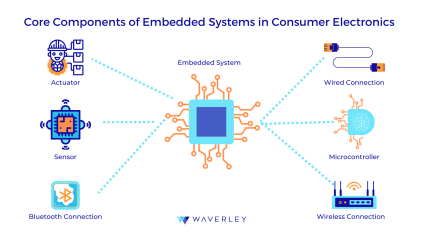
Automotive: Embedded Software Development
Automotive embedded software refers to specialized software intricately integrated within contemporary vehicles. This software oversees and manages microprocessors and assorted hardware enclosed within electronic control units (ECUs), ensuring the smooth operation of vital automotive functions such as braking, navigation, and safety.
Why are automotive embedded systems in high demand?
Automotive embedded software systems are responsible for the rapid pace of innovation in the transportation sector. Today, high-end vehicles are powered by 70-100 ECUs running over 100 million lines of code. As we move into the future of networked, electric, and autonomous mobility, automated embedded systems will lead the way.
| Performance | Comfort | Safety | Environmental |
|---|---|---|---|
| Automotive embedded systems power the engine monitoring and fuel control systems responsible for vehicle speed, torque, and performance. | Climate control, cruise control, and infotainment systems deliver unparalleled, personalized comfort on the road. | Electronic Stability Control, Pedestrian Monitoring, and Active/Passive Safety Restraints respond instantaneously to reduce risk on the road. | Hybrid, electric, alternative fuel, and other embedded systems play a crucial role in enabling a zero-waste future. |
Our Experience
With over 30+ years of experience, our team has worked on multiple projects designing software for embedded systems. Our portfolio includes projects on embedded development for smart homes, medical devices for healthcare, hardware testing, robotics, embedded software development for EV chargers, etc.
- Embedded Software Development for EV Chargers
Working with the energy provider for Electric Vehicles, Waverley helped to set up their hardware, ensure smooth operation, and increase the speed of device testing in production. Waverley continues to help the client develop new features and automate vital production processes. Our engineers adjusted the software architecture to fit both new and old hardware models for smoother software updating and new feature implementation in the future (e.g. providing the EV with fast charging, internet connection, and multimedia). - Music Streaming Device
Waverley partnered with the manufacturer of a music streaming device that’s integrated with Spotify. Waverley’s expertise in embedded & IoT development, helped them create system drivers and expand functionality to enable integration with other music services, such as Amazon Music. We also built custom iOS and Android mobile clients to manage the devices and assisted with DevOps infrastructure to integrate CI/CD into the client’s development process. - Home Automation: Embedded Development for Smart Home
Working with the leading Smart Home company, Waverley created a hybrid mobile application allowing remote monitoring and control of security, heating, and electricity for home management devices. We also helped the client develop embedded software for security panels and voice communication. - Seagate: Hardware Testing for the Leading Storage Provider
Over the years Waverley’s been a dedicated testing partner for Seagate, providing a team of QA engineers in Vietnam to test Seagate’s hard disc drives. Under extremely tight schedules, Waverley managed to speed up the overall testing time and ensure a successful product launch.
Conclusion
Overall, the embedded software development process is a multi-faceted journey that requires meticulous planning, robust design, and rigorous testing to ensure the creation of reliable and efficient systems. Adopting best practices such as maintaining a clear and structured development process, leveraging modular design principles, and incorporating continuous testing and validation can significantly enhance the quality and performance of embedded software.
The embedded system software market is growing rapidly and is predicted to maintain this growth, playing a bigger role in the IT industry. This is possible thanks to the increased usage of embedded systems in the healthcare industry, increased demand for electric and hybrid vehicles, and increased interest in sustainable movements. Thus, knowing how to make software for embedded systems is vital for any entrepreneur interested in embedded software development or embedded product development.
Having a trustworthy and experienced embedded development services provider will ensure quick success for your project/organization. Contact our consultants to get a glance at the development of embedded systems and discover how they can revolutionize your products and services in cutting-edge industries such as automotive, healthcare, and consumer electronics.
Innovate with embedded systems
FAQ
What is the embedded system development?
Embedded system development refers to the process of designing, programming, and maintaining specialized computing systems that perform dedicated functions or tasks within larger systems. Unlike general-purpose computers, embedded systems are designed for specific control functions within devices or machinery.
What programming language is used in embedded systems?
Programming languages used in embedded systems are chosen based on their efficiency, low-level hardware access, and real-time performance capabilities. For example, here are the most common programming languages used in embedded systems: C, C++, Assembly Language, Python, Java, Ada, and Rust.
What role does embedded software play in IoT (Internet of Things) devices?
Embedded software is the backbone of IoT devices, enabling them to perform their intended functions efficiently and securely. For example, embedded software provides the core functionality of IoT devices, controlling hardware components and enabling them to perform specific tasks. Also, embedded software interfaces with various sensors to collect data from the environment, such as temperature, humidity, motion, and more. Or embedded software implements networking protocols (e.g., Wi-Fi, Bluetooth, Zigbee, MQTT) to enable IoT devices to communicate with each other and with central systems or cloud services. There are examples of the key features of how embedded software works together with IoT devices.
What is the embedded software development life cycle?
The embedded software development life cycle is a structured process used to design, develop, test, and maintain embedded software. It includes several stages that ensure the development of reliable and efficient software tailored for specific hardware and applications.


